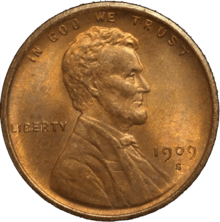Key date
In coin collecting, a key date refers to a date (or date and mint mark combination) of a given coin series or set that is harder to obtain than other dates in the series. The next level of difficult to obtain coins in series are often referred to as semi-key dates or simply semi-keys.[1]

For example, the 1909-S VDB is the key date in the Lincoln cent series. The 1914-D and 1931-S are considered semi-keys. In the United Kingdom £1 coins from 1988 are considered key date coins.
What makes a coin a "key" is somewhat more complicated because there are many issues that are easy to obtain in lower grades and very hard to find in higher ones. Collectors who want a series in near uncirculated condition may find some date/mint combinations extremely rare. This is because low mintage coins were frequently kept by collectors and saw little or no circulation, while common dates were rarely saved and typically became heavily worn. Another factor in making these conditional rarities is that in certain years some or all of the mints did poor strikings of a coin. For example, finding the common 1919-D Walking Liberty half dollar in well struck, near-perfect uncirculated condition, is an almost impossible challenge for even the collector of substantial means.
Professional and avid coin collectors will often not simply collect coins, but will specialize on a specific types of coin and then attempt to collect every coin in the series, i.e. one from every year that type of coin was minted with all variations. These variations most typically include the mint mark, but other variations can exist. One possibility can be the material in which the coin was minted. In some years, for example, the same coin might be minted from two or even three different metal combinations, such as steel, nickel, iron, gold, bronze, or silver. The Eisenhower dollar, for example, was minted in cupronickel for circulation strikes but in 40% silver for proof and uncirculated collector specimens from 1971 through 1976. Artistic differences or errors on the die that struck the coins and at the highest quality that can be found are also possible varieties a collector might pursue. The 1922 "no D" and "weak D" Lincoln cents are an examples in which extremely worn dies struck coins with missing or very faint mint marks. The 1942/1 Mercury dime minted in 1942 is another example, in which a hubbing error produced coins on which the final digit of the date shows a "2" superimposed over a "1".
Experienced collectors may begin a collection by first obtaining specimens of the key dates, as "key date" coins for a set are often what prevents the collection from being a complete set. Once the key dates, which often represent the major share of the collection's value, are obtained completing the set is a fairly straightforward matter.
Partial List of Key Date U.S. Coins
- 1793 Chain Cent
- 1799 Draped Bust Cent
- 1804 Draped Bust Cent
- 1823 Capped Bust Cent
- 1856 Flying Eagle Cent
- 1877 Indian Head Cent
- 1909-S Indian Head Cent
- 1909-S VDB Lincoln Cent
- 1909-S Lincoln Cent
- 1914-D Lincoln Cent
- 1922 No D Lincoln Cent
- 1931-S Lincoln Cent
- 1955 Doubled Die Obverse Lincoln Cent
- 1972 Doubled Die Obverse Lincoln Cent
- 1885 Liberty Nickel
- 1886 Liberty Nickel
- 1912-S Liberty Nickel
- 1913 Liberty Nickel
- 1913-S "Type 2" Buffalo Nickel
- 1916 Doubled Die Obverse Buffalo Nickel
- 1926-S Buffalo Nickel
- 1937-D "3 Legs" Buffalo Nickel
- 1950-D Jefferson Nickel
- 1873-CC "No Arrows" Liberty Seated Dime
- 1894-S Barber Dime
- 1916-D Mercury Dime
- 1921-D Mercury Dime
- 1949-S Roosevelt Dime
- 1982 "No P" Roosevelt Dime
- 1996-W Roosevelt Dime
- 1896-S Barber Quarter
- 1901-S Barber Quarter
- 1913-S Barber Quarter
- 1916 Standing Liberty Quarter
- 1932-D Washington Quarter
- 1932-S Washington Quarter
- 1878-S Liberty Seated Half Dollar
- 1892-O "Micro O" Barber Half Dollar
- 1916-S Walking Liberty Half Dollar
- 1921-D Walking Liberty Half Dollar
- 1938-D Walking Liberty Half Dollar
- 1804 Bust Dollar
- 1870-S Liberty Seated Dollar
- 1879-CC Morgan Dollar
- 1884-S Morgan Dollar
- 1889-CC Morgan Dollar
- 1892-S Morgan Dollar
- 1893-CC Morgan Dollar
- 1893-S Morgan Dollar
- 1894 Morgan Dollar
- 1895 Morgan Dollar
- 1895-O Morgan Dollar
- 1895-S Morgan Dollar
- 1901 Morgan Dollar
- 1921 Peace Dollar
- 1928 Peace Dollar
- 1934-S Peace Dollar
- 1854-S Half Eagle
- 1875 Half Eagle
References
- Susan Headley (21 June 2017). "What Is a Key Date?". Retrieved 17 November 2017.